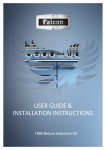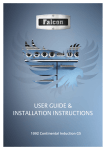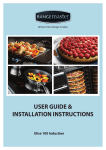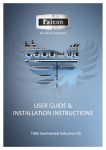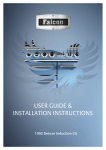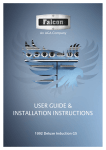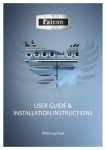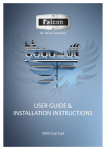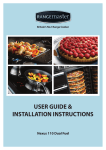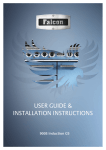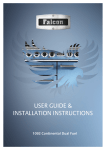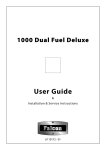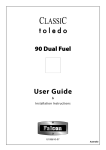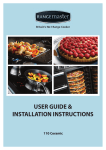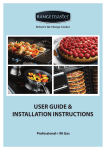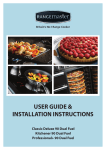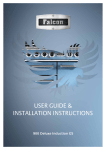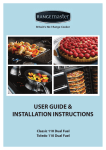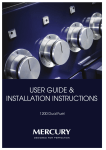Download USER GUIDE & INSTALLATION INSTRUCTIONS
Transcript
USER GUIDE & INSTALLATION INSTRUCTIONS Nexus 110 Dual Fuel SLOW BAKED LEG OF LAMB METHOD 1. Preheat the oven to 220 ¡C (for a conventional oven), 200 ¡C (for a fan oven) or gas mark 7. 2.Pull the small sprigs off the rosemary branches and set aside with the garlic. 2. Using the tip of a paring knife, make up to 20 well-spaced cuts into the flesh of the lamb, about 2.5 cm inch deep. Divide the rosemary sprigs, garlic and anchovies and push down into the cuts. Place the leg on a large roasting tin and pour over the oil, massaging it all over the joint. Season well with salt and pepper and pour the wine and 250 ml water into the tin. 3. Put into the oven and sear for 15 minutes, then turn the temperature right down to 130 ¡C (conventional oven), 110 ¡C (fan oven) or gas mark 1 and roast for 4Ð5 hours, basting every 30 minutes or so. Basting frequently helps to keep the meat moist and encourages the build up of a good glaze on the outside. Add more liquid (wine or water) if the tin looks dry Ð there should always be liquid in the tin throughout this cooking process. INGREDIENTS ¥ 2Ð3 large sprigs of rosemary ¥ 4 large garlic cloves cut in half lengthways ¥ 1.8 kg leg of lamb ¥ 8 good quality anchovy fillets, halved ¥ 100 ml olive oil ¥ 250 ml dry red wine ¥ Maldon salt and freshly ground black pepper 4. The meat is ready when it starts to fall off the bone, at which point it should have a core temperature of 90 ¡C. Remove from the oven, transfer to a warmed carving dish, cover loosely with foil and leave to rest in a warm place for 30Ð45 minutes before carving. 5. Pour the juices from the tin into a tall hi-ball glass and allow to settle. Spoon the fat from the top of the glass. There should be enough sticky, reduced juices for an intense gravy hit Ð if not, pour the juices you have back into the roasting tin and put it over the heat, pour in a splash of water or wine and deglaze the tin scraping up all the sticky bits from the base. Boil fast until syrupy, taste and correct the seasoning. RASPBERRY SOUFFLƒÉ METHOD 1. For the soufflŽ, press the raspberries through a fine sieve to produce 180 g of purŽe. Put this into a heavybottomed pan, add the lemon juice and reduce down to a thick jam, stirring from time to time and being careful not to let it catch and burn. 2. Put 45 g of the sugar in a separate pan. Melt it and then boil until it becomes a thick syrup (121 ¡C on a sugar thermometer). To test without a thermometer, dip a teaspoon into the syrup and then dip quickly into cold water. You should be able to roll the cooling syrup into a ball between your fingers. Be careful as the syrup is extremely hot. When it has reached the right point, stir the hot syrup into the raspberry jam. 3. Mix the framboise and cornflour together and stir into the jam over the heat. Turn the jam into a small bowl, sprinkle the surface with icing sugar and cover with cling film. INGREDIENTS ¥ 400 g raspberries ¥ 1 tbsp lemon juice ¥ 100 g caster sugar ¥ 2 tsp cr�me de framboise ¥ 1 tsp cornflour ¥ 180 g egg whites (about 6) ¥ Pinch of cream of tartar or a squeeze of lemon juice ¥ Icing sugar for dusting 4. Preheat the oven (not grill) to 180 ¡C shelf level 2 (conventional oven), 160 ¡C (fan oven) or gas mark 4 centre shelf. 5. Whisk the egg whites with the cream of tartar until you can form soft peaks, then fold in the remaining caster sugar. Lightly fold the whites into the jam, leaving thin traces of white visible in the mixture. 6. Spoon into four large buttered and sugared ramekins, place these on a baking tray and bake for 10 minutes. 7. Dust with icing sugar. Contents 1. Before You Start... 1 Important!1 Installation and Maintenance 1 Peculiar smells 1 If you smell gas 1 Ventilation1 Personal Safety 1 Cooker Care 3 4 7.Installation 24 Dear Installer 24 Safety Requirements and Regulations 24 Provision of Ventilation 24 Location of Cooker 24 Positioning the Cooker 26 Moving the Cooker 27 Fitting the Stability Bracket or Chain 28 Hotplate Burners 4 Wok Burner 5 Repositioning the Cooker Following Connection28 The Wok Cradle 5 Conversion to Another Gas The Ceramic Hotplate 6 Levelling28 The Griddle 7 Gas Connection 29 The Glide-out Grill™ 8 Electrical Connection 30 Bread Proving Drawer 9 Final Checks 31 The Ovens 10 Final Fitting 31 Using the Clock 12 Customer Care 31 Accessories14 3. 22 Conversion24 Cleaning3 2. Cooker Overview 6.Troubleshooting Oven Lights 14 Cooking Tips 15 Tips on Cooking with the Timer 15 General Oven Tips 15 4. Cooking Table 16 5. Cleaning Your Cooker 17 Essential Information 17 Hotplate Burners 17 Ceramic Hotplate 18 The Griddle 18 Glide-out Grill™ 19 Control Panel and Doors 20 28 8. Circuit Diagram 32 9. Technical Data 33 Ovens20 Cleaning Table Nexus 110 Dual Fuel 21 i U110323-01 ii 1. Before You Start... If you smell gas Your cooker should give you many years of trouble-free cooking if installed and operated correctly. It is important that you read this section before you start, particularly if you have not used a dual fuel cooker before. • DO NOT turn electric switches on or off. • DO NOT smoke • DO NOT use naked flames • DO turn off the gas at the meter or cylinder • DO open doors and windows to get rid of the gas • DO keep people away from the area affected • Call your gas supplier. If you are using natural gas in the UK, ring the National Grid on: 0800 111 999. Important! CAUTION: This appliance is for cooking purposes nn only. It must not be used for other purposes, for example room heating. Using it for any other purpose could invalidate any warranty or liability claim. Besides invalidating claims this wastes fuel and may overheat the control knobs. Installation and Maintenance Ventilation This cooker must be installed in accordance with the relevant instructions in this booklet, with the relevant national and local regulations, and with the local gas and electricity supply companies’ requirements. The use of a gas cooking appliance results in the production of heat and moisture in the room in which it is installed. Therefore, ensure that the kitchen is well ventilated: keep natural ventilation holes open or install a powered cooker hood that vents outside. If you have several burners on, or use the cooker for a long time, open a window or turn on an extractor fan. Make sure that the gas supply is turned on and that the cooker is wired in and switched on (the cooker needs electricity). Personal Safety Set the clock to make sure that the oven is functional – see the relevant section in this manual. DO NOT modify this appliance. nn This appliance can be used by children aged from 8 nn Only a qualified service engineer should service the cooker, and only approved spare parts should be used. years and above and persons with reduced physical, sensory or mental capabilities or lack of experience and knowledge if they have been given supervision or instruction concerning use of the appliance in a safe way and understand the hazards involved. Children shall not play with the appliance. Cleaning and user maintenance shall not be made by children without supervision. Always allow the cooker to cool and then switch it off at the mains before cleaning or carrying out any maintenance work, unless specified otherwise in this guide. Peculiar smells When you first use your cooker it may give off a slight odour. This should stop after a little use. Before using for the first time, make sure that all packing materials have been removed and then, to dispel manufacturing odours, turn the ovens to 200°C and run for an hour. This appliance is not intended for use by young nn Before using the grill for the first time you should also turn on the grill and run for 30 minutes with the grill pan in position, pushed fully back, and the grill door open. CAUTION: A long term cooking process has to be nn Make sure the room is well ventilated to the outside air (see ‘Ventilation’ below). People with respiratory or allergy problems should vacate the area for this brief period. Danger of fire: DO NOT store items on the cooking nn children or infirm persons unless they have been adequately supervised by a responsible person to make sure that they can use the appliance safely. supervised from time to time. A short term cooking process has to be supervised continuously. surfaces. To avoid overheating, DO NOT install the cooker nn behind a decorative door. WARNING: The appliance and its accessible parts nn become hot during use and will retain heat even after you have stopped cooking. Care should be taken to avoid touching heating elements. Children less than 8 years of age shall be kept away unless continuously supervised. DO NOT use a steam cleaner on your cooker. nn 1 Accessible parts will become hot during use and will nn Fig.1-1 retain heat even after you have stopped cooking. Keep babies and children away from the cooker and never wear loose-fitting or hanging clothes when using the appliance. Always be certain that the controls are in the OFF position when the oven is not in use, and before attempting to clean the cooker. ArtNo.324-0001 Steam burst When the oven is on, DO NOT leave the oven door nn open for longer than necessary, otherwise the control knobs may become very hot. Fig.1-2 When using the grill, make sure that the grill pan nn is in position and pushed fully in, otherwise the control knobs may become very hot. DO NOT use harsh abrasive cleaners or sharp metal nn scrapers to clean the oven door glass since they can scratch the surface, which may result in shattering of the glass. Always keep combustible materials, e.g. curtains, and flammable liquids a safe distance away from your cooker. Never store flammable materials in the drawer. nn This includes paper, plastic and cloth items, such Fig.1-3 as cookbooks, plastic ware and towels, as well as flammable liquids. Do not store explosives, such as aerosol cans, on or near the appliance. DO NOT spray aerosols in the vicinity of the cooker nn while it is on. Use dry oven gloves when applicable – using damp gloves might result in steam burns when you touch a hot surface. Do not use a towel or other bulky cloth in place of a glove – it might catch fire if brought into contact with a hot surface. ArtNo.312-0003 Moving pans NEVER operate the cooker with wet hands. nn DO NOT use aluminium foil to cover shelves, linings nn or the oven roof. DO NOT use hotplate protectors, foil or hotplate nn covers of any description. These may affect the safe use of your hotplate burners and are potentially hazardous to health. NEVER heat unopened food containers. Pressure nn build up may make the containers burst and cause injury. DO NOT use unstable saucepans. Always ensure that nn you position the handles away from the edge of the hotplate. DO NOT use cooking vessels on the hotplate that nn overlap the edges. Never leave the hotplate unattended at high heat settings. Pans boiling over can cause smoking, and greasy spills may catch on fire. Use a deep fat thermometer whenever possible to prevent fat overheating beyond the smoking point. 2 WARNING! nn Unattended cooking on a hob with fat or oil can be nn dangerous and may result in fire. DO NOT place anything between the base of the pan nn and the heating zone surface (e.g. asbestos mats, aluminium foil, wok cradle). NEVER leave a chip pan unattended. Always heat fat slowly, and watch as it heats. Deep fry pans should be only one third full of fat. Filling the pan too full of fat can cause spill over when food is added. If you use a combination of oils or fats in frying, stir them together before heating or as the fats melt. nn Take care NOT to place metallic objects such as nn knives, forks, spoons and lids on the hob surface since they can get hot. The appliance is not intended to be operated by nn means of external timer or separated remote-control system. Foods for frying should be as dry as possible. Frost on frozen foods or moisture on fresh foods can cause hot fat to bubble up and over the sides of the pan. Carefully watch for spills or overheating of foods when frying at high or medium high temperatures. Never try to move a pan of hot fat, especially a deep fat fryer. Wait until the fat is cool. Avoid warming an empty pan. Doing so may damage nn both the heating zone and pan. Only certain types of glass, glass-ceramic, earthenware or other glazed containers are suitable for use on the heating zone; others may break because of the sudden change in temperature. DO NOT use the top of the flue (the slot along the nn back of the cooker) for warming plates, dishes, drying tea towels or softening butter. Cooker Care DO NOT use water on grease fires and never pick nn up a flaming pan. Turn the controls off and then As steam can condense to water droplets on the cool outer trim of the oven, it may be necessary during cooking to wipe away any moisture with a soft cloth. This will also help to prevent soiling and discolouration of the oven exterior by cooking vapours. smother a flaming pan on a surface unit by covering the pan completely with a well fitting lid or baking tray. If available, use a multipurpose dry chemical or foam-type fire extinguisher. Cleaning Cooking high moisture content foods can create a ‘steam burst’ when the oven door is opened (Fig.1-1). When opening the oven stand well back and allow any steam to disperse. In the interests of hygiene and safety, the cooker should be kept clean at all times as a build up in fats and other food stuff could result in a fire. Take care that no water seeps into the appliance. Clean only the parts listed in this guide. This appliance is heavy so take care when moving it. nn Clean with caution. If a wet sponge or cloth is used to wipe spills on a hot surface, be careful to avoid steam burns. Some cleansers can produce noxious fumes if applied to a hot surface. Ceramic Heating Zone NEVER attempt to cook directly on the heating zone. nn DO NOT use the heating zone surface as a cutting nn board. DO NOT leave utensils, foodstuff or combustible nn items on the heating zone when it is not in use (e.g. tea towels, frying pans containing oil). DO NOT place plastic or aluminium foil, or plastic nn containers, on the heating zone. DO NOT leave the heating zone switched on unless nn being used for warming. DO NOT stand or rest heavy objects on the heating nn zone. Although the ceramic surface is very strong, a sharp blow or sharp falling object (e.g. a salt cellar) might cause the surface to crack or break (Fig.1-2). Should a crack appear in the surface, disconnect the nn cooker immediately from the supply and arrange for its repair. Always LIFT pans off the heating zone. Sliding pans may cause marks and scratches (Fig.1-3). Always turn the control to the ‘OFF’ position before removing a pan. 3 2. Cooker Overview A Fig.2-1 B C E D F The 110 dual fuel cooker (Fig.2-1) has the following features: Fig.2-2 A. 4 hotplate burners, a Wok Burner and a Ceramic B. C. D. E. F. Multizone hotplate Control Panel Glide-out Grill™ with 4 position Trivet Multifunction Oven Fan Oven Bread Proving/Storage Drawer Hotplate Burners The labels by each of the control knobs indicates which area that knob controls. Each burner has a Flame Supervision Device (FSD) that prevents the flow of gas if the flame goes out. When a hotplate control knob is pressed in, sparks will be made at every burner – this is normal. Do not attempt to disassemble or clean around any burner while another burner is on, otherwise an electric shock could result. To light a burner, push in and turn the associated control knob to the high position as indicated by the large flame symbol (H), (Fig.2-2). 4 The igniter should spark and light the gas. Continue to press in the knob to let the gas through to the burner for about ten seconds. Fig.2-3 If and when you let go of the control knob or the burner goes out, then the FSD has not been bypassed. Turn the control knob to the OFF position and wait for one minute before you try again, this time making sure to hold in the control knob for slightly longer. Adjust the flame height to suit by turning the knob counterclockwise (Fig.2-3). On this cooker the low position is beyond high, NOT between high and off. Fig.2-5 Fig.2-4 If a burner flame goes out, turn off the control knob and leave it for one minute before relighting it. Make sure that the flames are under the pans. Using a lid will help the contents boil more quickly (Fig.2-4). ArtNo.311-0002 Pan with rim Large pans should be spaced well apart. Pans and kettles with concave bases or down-turned base rims should not be used (Fig.2-5). ArtNo.311-0001 Right pans gas Simmering aids, such as asbestos or mesh mats, are NOT recommended (Fig.2-6). They will reduce burner performance and could damage the pan supports. Fig.2-7 Fig.2-6 You should also avoid using unstable and misshapen pans that may tilt easily, and pans with a very small base diameter, e.g. milk pans, single egg poachers (Fig.2-7). Art No. 311-0003 Simmer aids The minimum recommended pan diameter is 120 mm. The maximum allowable pan base diameter is 260 mm. ArtNo.311-0004 Tipping wok Fig.2-8 DO NOT use cooking vessels on the hotplate that overlap the edges. Wok Burner The Wok Burner is designed to provide even heat over a large area. It is ideal for large pans and stir-frying (Fig.2-8). For heating smaller pans, the aforementioned hotplate burners may be more efficient. You should wipe the enamel top surface of the cooker around the hotplate burners as soon as possible after spills occur. Try to wipe them off while the enamel is still warm. Fig.2-9 Note: The use of aluminium pans may cause metallic marking of the pan supports. This does not affect the durability of the enamel and may be cleaned off with a suitable metal cleaner. The Wok Cradle The Wok Cradle is designed to fit a 35 cm wok. If you use a different wok, make sure that it fits the cradle. Woks vary very widely in size and shape. It is important that the wok sits down on the pan support – however, if the wok is too small, the cradle will not support it properly (Fig.2-9). ArtNo.311-0006 Correct wok sizes Fig.2-10 The cradle should be used on the wok burners only. When you fit the cradle, check that it is supported properly on a pan support and that the wok is sitting level in the cradle (Fig.210). The cradle will get very hot in use – allow plenty of time for it to cool before you pick it up. ArtNo.311-0007 Wok stand close-up 5 The Ceramic Hotplate Fig.2-11 The hotplate area on the left-hand side is dual purpose. It can be used either as a ceramic hob to heat a pan in the usual way (Fig.2-11) or it can be used to heat the supplied griddle. The rear area, marked with a ring, is for cooking with a pan. There are two elements that allow either the whole of the area to be heated or just the rear half. To heat the whole area, turn the hotplate control clockwise (Fig.2-12). To use the rear ring only, turn the hotplate control counterclockwise (Fig.2-13). Fig.2-12 The neon indicator light above the control knob will come on when the hotplate control is turned on and stay lit while the surface cools. You can also place a large fish kettle across both heating zones. ArtNo.274-0008 Prof DL warmer control 1 Always take care before touching the surface even when it is turned off – it may be hotter than you think. Use only pans that are suitable for ceramic hobs. We recommend stainless steel and enamelled steel pans because pots and pans with copper or aluminium bases leave traces on the hob that are difficult to remove. Fig.2-13 Pots and pans should have thick, smooth, flat bottoms (Fig.2-14). This makes sure the maximum heat transfer from the hob to the pan, making cooking quick and energy efficient. Never use a round-bottomed wok, even with a stand. The very best pans have bases that are very slightly curved up when cold. If you hold a ruler across the bottom you will see a small gap in the middle (Fig.2-15). When they heat up the metal expands and lies flat on the cooking surface. ArtNo.274-0008 Prof DL warmer control 1 Make sure that the base of the pan is clean and dry to prevent any residue burning onto the hob panel. This also helps prevent scratches and deposits. Fig.2-14 Always use pans that are the same size as (or slightly larger than) the areas marked on the hob top (Fig.2-16). Using smaller pans wastes heat, and any spillage will be burnt on. Using a lid will help the contents boil more quickly. Always lift pans off the hob. Sliding pans may cause marks and scratches. Always turn the control to the ‘OFF’ position before removing a pan. When cooking on the hob you may see the hob area you are using switch off and on. This is caused by a safety device that limits the temperature of the hob. It is quite normal, especially when cooking at high temperatures. If it happens a lot with a particular pan however it may mean the pan is not suitable – perhaps too small or too uneven – for a ceramic hob. Fig.2-15 For best results, preheat a covered serving dish for 10 minutes before adding food to it. Use only heat-resistant dishes. 6 The Griddle Fig.2-16 The griddle (Fig.2-17) is designed to fit securely on the locating pins over the ceramic heating area (Fig.2-18). DO NOT try to use it over one of the gas burners. It will not be securely held and you may damage the non-stick finish. To heat the whole area, turn the hotplate control clockwise (Fig.2-19). ArtNo.312-0006 Correct pan sizes The neon indicator light above the control knob will come on when a hob control is turned on and stay lit while the surface cools. It is designed for cooking food on directly. DO NOT use pans of any kind on it. The griddle surface is non-stick and metal cooking utensils (e.g. spatulas) will damage the surface. Use heat resistant plastic or wooden utensils. Fig.2-17 The griddle can be lightly brushed with cooking oil before use. Preheat the griddle for a maximum of 5 minutes before adding food. Leaving it longer may cause damage. There is a gap at the right-hand rear corner of the griddle (Fig.2-20) so you can pour off excess fat after cooking. Fig.2-18 Be careful – it may be very hot. nn After cooking, allow the griddle to cool before cleaning. Fig.2-19 ArtNo.274-0008 Prof DL warmer control 1 Fig.2-20 7 The Glide-out Grill™ Fig.2-21 Open the door and pull the grill pan carriage forward using the handle (Fig.2-21). The grill has two elements that allow either the whole area of the pan to be heated or just the right-hand half. Adjust the heat to suit by turning the control knob. To heat the whole grill, turn the knob clockwise (Fig.2-22). To heat the right-hand half, turn the knob counter-clockwise. The neon indicator light by the grill control will come on. For best results, slide the carriage back into the grill chamber and preheat the appropriate part(s) of the grill for two minutes. The grill trivet can be removed and the food placed on it while you are waiting for the grill to preheat. Fig.2-22 DO NOT leave the grill on for more than a few nn moments without the grill pan underneath it, otherwise the knobs may become hot. Once the grill has preheated, slide the carriage out again. With the trivet back in place with the food on it, slide the carriage back into the grill chamber. Make sure that it is pushed right in. Fig.2-23 CAUTION: Accessible parts may be hot when the grill nn is in use. Young children should be kept away. 1 The grill pan trivet can be set to four different grilling heights by a combination of turning it back to front and turning it upside down (Fig.2-23). 2 Do not leave the grill on for more than a few moments, without the grill pan underneath it. 3 Never close the grill door when the grill is on. nn CAUTION: This applicance is for cooking purposes nn only. It must not be used for other purposes, for example room heating. 4 8 Bread Proving Drawer Fig.2-24 The Bread Proving Drawer is found on the right at the base of the cooker (Fig.2-24). Within the Bread Proving Drawer there are slots in the base to allow warmed air to flow through into the drawer from the element underneath. The Bread Proving Drawer temperature is ideal for proving all sorts of yeast dough from sweet to savoury, gluten free to sourdough, dough made from fresh yeast and dried, bread mixes and recipes from the Rangemaster Good Housekeeping Cookery book. F Pre heat the drawer so that it is warm and ready for your dough. Fig.2-25 It is operated by a pushbutton (Fig.2-25). There is no need to set the temperature, this is already set. The Bread Proving Drawer has space for: • Baking trays, no larger than 340mm x 340mm, to prove bread rolls or buns; these can then be put straight into a preheated oven after proving. • To prove 2 trays at once in the drawer use a cooling rack or trivet over the top of one tray with the other on top, remember to allow space for the dough to expand during the proving time. • 3 litre bowl full of dough • 3 x 2 pound loaf tins • 4 x 1 pound loaf tins The time needed for proving will depend upon the dough type and the amount. Refer to the recipe for guidance and check the dough during the proving time. Cleaning Clean the inside of the drawer with hot soapy water and a soft cloth, rinse and dry. The Bread Proving Drawer is ideal for storing baking trays and other cooking utensils. It can get warm, so do not store anything in it that may melt or catch fire. If a large baking tray is used, place a cooling rack on to the base of the drawer, and put the tray on top, this will allow the warmed air to reach the dough. Never store flammable materials in the drawer. nn This includes paper, plastic and cloth items, such When preparing larger quantities of yeast dough, containing 500g or over of flour, divide the dough into 2 bowls or containers, this will make proving in the drawer easier. as cookbooks, plastic ware and towels, as well as flammable liquids. Do not store explosives, such as aerosol cans, on or nn near the appliance. Keep an eye on the dough while it is proving; fresh yeast can work quickly especially if it has had a first fermentation stage (sometimes called sponging). Sponging can help produce a slightly lighter loaf. Flammable materials may explode and result in fire nn or property damage. TOP TIPS Not sure of the capacity of your loaf tins? • A one pound loaf tin will hold 800ml of water • A two pound loaf tin will hold 1.5 litres of water. • Cover the dough while it is proving with greased cling film, be careful not to anchor the cling film too tightly so that it prevents the dough from rising. The Bread Proving Drawer can be used for storage. If you have used the Bread Proving Drawer, switch it off and wait until the drawer cools before storing any items. NOTE: The Bread Proving Drawer will not warm plates 9 The Ovens Multifunction Oven Functions The clock must be set to the time of day before the ovens will work. See the following section on ‘The Clock’ for instructions on setting the time of day. Fan Oven This function operates the fan and the heating element around it. An even heat is produced throughout the oven, allowing you to cook large amounts quickly. References to ‘left-hand’ and ‘right-hand’ ovens apply as viewed from the front of the appliance. Fan oven cooking is particularly suitable for baking on several shelves at one time and is a good ‘all-round’ function. It may be necessary to reduce the temperature by approximately 10 °C for recipes previously cooked in a conventional oven. The left-hand oven is a multifunction oven, while the righthand oven is a fan oven. The Multifunction Oven As well as the oven fan and fan element, multifunction ovens are fitted with two extra heating elements, one visible in the top of the oven and the second under the oven base. Take care to avoid touching the top element and element deflector when placing or removing items from the ovens. If you wish to preheat the oven, wait until the indicator light has gone out before inserting the food. Fanned Grilling This function operates the fan whilst the top element is on. It produces a more even, less fierce heat than a conventional grill. For best results, place the food to be grilled on a trivet over a roasting tin, which should be smaller than a conventional grill pan. This allows greater air circulation. Thick pieces of meat or fish are ideal for grilling in this way, as the circulated air reduces the fierceness of the heat from the grill. The multifunction oven has 3 main cooking functions: fan, fan assisted and conventional cooking. These functions should be used to complete most of your cooking. The browning element and base heat can be used in the latter part of the cooking process to fine tune the results to your particular requirements. Use fanned grilling for all your grilling needs and defrost to safely thaw small items of frozen food. The oven door should be kept closed while grilling is in progress, so saving energy. You will also find that the food needs to be watched and turned less than for normal grilling. Preheat this function before cooking. Table 2-1 gives a summary of the multifunction modes. Function Use Defrost To thaw small items in the oven without heat Fan oven A full cooking function, even heat throughout, great for baking Fanned grilling Grilling meat and fish with the door closed Fan assisted A full cooking function good for roasting and baking Conventional oven A full cooking function for roasting and baking in the lower half of the oven Browning element To brown and crisp cheese topped dishes Base heat To crisp up the bases of quiche, pizza or pastry For best results we recommend that the grill pan is not located on the uppermost shelf. Fan Assisted Oven This function operates the fan, circulating air heated by the elements at the top and the base of the oven. The combination of fan and conventional cooking (top and base heat) makes this function ideal for cooking large items that need thorough cooking, such as a large meat roast. It is also possible to bake on two shelves at one time, although they will need to be swapped over during the cooking time, as the heat at the top of the oven is greater than at the base, when using this function. This is a fast intensive form of cooking; keep an eye on the food cooking until you have become accustomed to this function. Table 2-1 The multifunction ovens have many varied uses. We suggest you keep a careful eye on your cooking until you are familiar with each function. Remember – not all functions will be suitable for all food types. Conventional Oven (Top and Base Heat) Please remember that all cookers vary – temperatures in your new ovens may differ to those in your previous cooker. Food cooked on the top shelf will brown and crisp faster than on the lower shelf, because the heat is greater at the top of the oven than at the base, as in ‘Fan Assisted Oven’ function. Similar items being cooked will need to be swapped around for even cooking. This means that foods requiring different temperatures can be cooked together, using the cooler zone in the lower half of the oven and hotter area to the top. This function combines the heat from the top and base elements. It is particularly suitable for roasting and baking pastry, cakes and biscuits. 10 The exposed top element may cook some foods too quickly, so we recommend that the food be positioned in the lower half of the oven to cook. The oven temperature may also need to be lowered. Fig.2-26 Browning Element This function uses the element in the top of the oven only. It is a useful function for the browning or finishing of pasta dishes, vegetables in sauce, shepherds pie and lasagne, the item to be browned being already hot before switching to the top element. Base Heat Function control This function uses the base element only. It will crisp up your pizza or quiche base or finish off cooking the base of a pastry case on a lower shelf. It is also a gentle heat, good for slow cooking of casseroles in the middle of the oven or for plate warming. Temperature control Fig.2-27 ArtNo.270-0005 Proplus electric oven control The Browning and Base Heat functions are useful additions to your oven, giving you flexibility to finish off items to perfection. Defrost This function operates the fan to circulate cold air only. Make sure the temperature control is at 0°C and that no heat is applied. This enables small items such as desserts, cream cakes and pieces of meat, fish and poultry to be defrosted. ArtNo.270-0006 Proplus oven control light Defrosting in this way speeds up the process and protects the food from flies. Pieces of meat, fish and poultry should be placed on a trivet, over a tray to catch any drips. Be sure to wash the trivet and tray after defrosting. Defrost with the oven door closed. Large items, such as whole chickens and joints should not be defrosted in this way. We recommend this be carried out in a refrigerator. Defrosting should not be carried out in a warm oven or when an adjoining oven is in use or still warm. Make sure that dairy foods, meat and poultry are completely defrosted before cooking. Fan Oven The right-hand oven is a fan oven that circulates hot air continuously, which means faster, more even cooking. The recommended cooking temperatures for a fan oven are generally lower than a conventional oven. Note: Please remember that all cookers vary so temperatures in your new ovens may differ to those in your previous cooker. 11 Fig.2-28 Operating the Ovens Fig.2-29 Operating the Multifunction Oven The multifunction oven has two controls: a function selector and a temperature setting knob (Fig.2-26). Turn the function selector control to a cooking function. Turn the oven temperature knob to the temperature required (Fig.2-27). ArtNo.306-0001 - 3-button clock The oven heating light will glow until the oven has reached the temperature you selected (Fig.2-28). It will then cycle on and off during cooking as the oven maintains the selected temperature. Fig.2-30 Operating the Fan Oven ArtNo.306-0001 - 3-button clock Turn the oven knob to the desired temperature (Fig.2-27). The oven indicator light will glow until the oven has reached the temperature selected (Fig.2-28). It will then cycle on and off during cooking. Fig.2-31 Using the Clock You can use the clock to turn the left-hand oven on and off. Note: When using the timer functions, first set the clock as required before setting the oven temperature. ArtNo.306-0001 - 3-button clock The oven can be switched on when the cook symbol [ ] is displayed. TOP TIP Setting the Clock 1. The LCD clock is shown in (Fig.2-29). Once the cooker is By pressing the mode [M] whilst Minute Minder is counting down, it is possible to see time remaining or adjust the countdown time using the [+] or [-] buttons. connected and switched on, the display flashes (00.00 ) and the time starts from (00.00 ). 2. To set the clock press the [+] and [-] buttons simultaneously, the point between hours and minutes will start to flash for 5 seconds. Whilst the point is flashing press either the [+] or [-] button to set the correct time. IMPORTANT: The timed oven will not operate unless the clock has been set. Fig.2-32 ArtNo.306-0001 - 3-button clock Program Selection - Setting the Minute Minder Fig.2-33 The minute minder [ ] provides the ability to set a countdown from 00.01h to 23.59h, at the end of which an alarm will sound. 1. ArtNo.306-0001 - 3-button clock 2. Fig.2-34 3. ArtNo.306-0001 - 3-button clock 12 Press the mode [M] button once (Fig.2-30). The bell symbol ( ) will flash on the display. Select the desired countdown from 00.01h to 23.59h using the [+] button (Fig.2-31). The countdown will automatically begin and the ( ) symbol will show in the display. Once the specified time has elapsed an alarm will sound. To stop the alarm press any button. Re-set the Minute Minder Fig.2-35 To re-set the minute minder, first select the minute minder program by pressing the mode [M] button. Then press the [+] and [-] buttons simultaneously. • • The ‘cook period’, which is the length of time you want the oven to cook for (dur). The ‘stop time’, which is the time of day you want the oven to stop cooking (End). ArtNo.306-0001 - 3-button clock Fig.2-36 To Stop the left-hand Oven at a Specific Time of Day 1. Press the mode [M] button 3 times, until the display 2. 3. 4. flashes (End) (Fig.2-32). Select the ‘stop time’ using the [+] or [-] buttons. The display will show the current time along with the AUTO and Cooking symbols (Fig.2-33). When the ‘stop time’ is reached an alarm will sound and the oven will stop working. The word AUTO will flash on the display (Fig.2-34). Press any button to stop the alarm and return to manual cooking. If the alarm is not stopped, it will stop automatically after 7 minutes. ArtNo.306-0001 - 3-button clock Fig.2-37 ArtNo.306-0001 - 3-button clock To Start and Then Stop the Left-hand Oven Set the left-hand oven to automatically start and stop using a combination of the ‘cook period’ and ‘stop time’. Fig.2-38 You cannot set a start time directly – this is set automatically by a combination of the ‘cook period’ and ‘stop time’. 1. 2. 3. 4. 5. ArtNo.306-0001 - 3-button clock Press the mode [M] button until the display flashes (dur) (Fig.2-35). Then set the ‘cook period’ using the [+] or [-] buttons. Press the mode [M] button until the display flashes (End) (Fig.2-36). Then set the ‘stop time’ using the [+] or [-] buttons. Current time will be displayed along with the word ‘AUTO’ (Fig.2-37). Set the oven to the required cooking temperature. During the ‘cook period’ the cook symbol [ ] is illuminated in the display. When cooking is finished an alarm will sound. Press any button to stop the alarm and return to manual cooking. If the alarm is not stopped, it will stop automatically after 7 minutes. Fig.2-39 ArtNo.306-0001 - 3-button clock AUTO is Showing, But You Want to Revert to Manual Cooking You can cancel any automatic settings by pressing the [+] and [-] buttons simultaneously. Changing the tone of the alarm It is possible to change the alarm tone. 1. 2. Press the the [+] and [-] buttons simultaneously, then the mode [M] button. The display will show (ton1,2 or 3) (Fig.2-38). To select the tone press the [-] button until desired tone is reached (Fig.2-39). 13 Accessories Fig.2-40 Flat shelf Oven Shelves Shelf guard In addition to the flat shelves, your cooker is supplied with a drop shelf (Fig.2-40). The drop shelf increases the possibilities for oven shelf spacing. The oven shelves can be easily removed and refitted. Front Pull the shelf forward until the back of the shelf is stopped by the shelf stop bumps in the oven sides (Fig.2-41). Shelf guard Drop shelf Lift up the front of the shelf so the back of the shelf will pass under the shelf stop and then pull the shelf forward (Fig.2-42). To refit the shelf, line up the shelf with a groove in the oven side and push the shelf back until the ends hit the shelf stop. Lift up the front so the shelf ends clear the shelf stops, and then lower the front so that the shelf is level and push it fully back (Fig.2-43). Front Fig.2-41 Fig.2-42 The Handyrack (Left-hand Oven) The Handyrack (Fig.2-44) fits to the left-hand oven door only. Food cooking on it is easy to attend to, because it is accessible when the door is open. ArtNo.320-0011 Removing the shelf 1 The maximum weight that can be held by the Handyrack is 5.5 kg (12 lb). It should only be used with the supplied roasting tin, which is designed to fit the Handyrack. Any other vessel could be unstable. ArtNo.320-0012 Removing the shelf 2 Fig.2-43 It can be fitted at two different heights. One of the oven shelves must be removed and the other positioned to suit. When the Handyrack is used in its highest position, other dishes can be cooked on the bottom shelf position or base of the oven. When the Handyrack is used in its lowest position, other dishes can be cooked on the second shelf position or base of the oven. ArtNo.320-0013 Removing the shelf 3 Fig.2-44 To fit the Handyrack, locate one side of it on the door bracket (Fig.2-45). Then spring the other side out to clip it onto the other bracket (Fig.2-46). Oven Lights Press the button to turn the lights on (Fig.2-47). ArtNo.320-0014 Handyrack on LH door Fig.2-45 If the oven light fails, turn off the power supply before changing the bulb. See the ‘Troubleshooting’ section for details on how to change the bulb. Fig.2-46 Fig.2-47 ArtNo.320-0017 Main oven light ArtNo.320-0015 Fitting the Handyack 1 ArtNo.320-0016 Fitting the handyrack 2 14 3. Cooking Tips Tips on Cooking with the Timer General Oven Tips If you want to cook more than one dish, choose dishes that require approximately the same cooking time. However, dishes can be ‘slowed down’ slightly by using small containers and covering them with aluminium foil, or ‘speeded up’ slightly by cooking smaller quantities or placing them in larger containers. The wire shelves should always be pushed firmly to the back of the oven. Baking trays with food cooking on them should be placed level with the front edge of the oven’s wire shelves. Other containers should be placed centrally. Keep all trays and containers away from the back of the oven, as overbrowning of the food may occur. Very perishable foods such as pork or fish should be avoided if a long delay period is planned, especially in hot weather. For even browning, the maximum recommended size of a baking tray is 340 mm (13½”) by 340 mm (13½”). DO NOT place warm food in the oven to be timed. nn DO NOT use a timed oven that is already warm. nn DO NOT use the timed oven if the adjoining oven is nn already warm. When the oven is on, do not leave the door open for longer than necessary, otherwise the knobs may get very hot. • Whole poultry must be thoroughly defrosted before being placed in the oven. Check that meat and poultry are fully cooked before serving. • • • • • 15 Always leave a “finger’s width” between dishes on the same shelf. This allows the heat to circulate freely around them. To reduce fat splashing when you add vegetables to hot fat around a roast, dry them thoroughly or brush lightly with cooking oil. Where dishes may boil and spill over during cooking, place them on a baking tray. The ‘Cook & Clean’ oven liners (see ‘Cleaning Your Cooker’) work better when fat splashes are avoided. Cover meat when cooking. Sufficient heat rises out of the oven while cooking to warm plates in the grill compartment. If you want to brown the base of a pastry dish, preheat the baking tray for 15 minutes before placing the dish in the centre of the tray. 4. Cooking Table DocNo.031-0004 - Cooking table - electric & fan single cavity The oven control settings and cooking times given in the table below are intended to be used AS A GUIDE ONLY. Individual tastes may require the temperature to be altered to provide a preferred result. Food is cooked at lower temperature in a fan oven than in a conventional oven. When using recipes, reduce the fan oven temperature by 10 °C and the cooking time by 5-10 minutes. The temperature in the fan oven does not vary with height in the oven so you can use any shelf. Top (T) Centre (C) Base (B) Oven Shelf Positions Conventional Oven Fan Oven Temperature °C Temperature (Shelf Position) °C 160 (C) 150 200 (C) 190 160 (C) 150 200 (C) 190 160 (C) 150 200 (C) 190 160 (C) 150 20-25 minutes per 500g +20-25 minutes. 200 (C) 190 15-20 minutes per 500g +15-20 minutes. 160 (C) 150 20 minutes per 500g +20 minutes. 200 (C) 190 15 minutes per 500g +15 minutes. 160 (C) 150 25-30 minutes per 500g. 200 (C) 190 20 minutes per 500g. 140-150 (C) 130-140 220 (C) 210 Large tins 30-35 minutes; individual 10-20 minutes. 140 (C/B) 130 45-50 minutes per 500g of mixture. Fruit 180 mm tin 150 (C/B) 140 2-2½ hours. Fruit 230 mm tin 150 (C/B) 140 Up to 3½ hours. Madeira 180 mm 160 (C/B) 150 80-90 minutes. Queen cakes 190 (C/B) 180 15-25 minutes. Scones 220 (C/B) 210 10-15 minutes. 180 mm tin 180 (C/B) 170 20-30 minutes. 210 mm tin 180 (C/B) 170 30-40 minutes. Shortcrust tarts 200 (C/B) 190 20-30 minutes on a preheated tray. Fruit pies 200 (C/B) 190 35-45 minutes. Tartlets 200 (C/B) 190 10-20 minutes according to size. Puff pastry 210 (C/B) 200 20-40 minutes according to size. Meringues 100 (C/B) 90 2-3 hours. Food ArtNo.050-0007 Oven shelf positions T - Top; C - Centre; B - Base Approximate Cooking Time Meat ArtNo.050-0001 Gas cooking table Beef (no bone) Lamb Pork Poultry Chicken Turkey Duck Casserole Yorkshire Pudding 30-35 minutes per 500g +30-35 minutes. Thoroughly thaw frozen joints before cooking. Meat may be roasted at 20-25 minutes per 500g +20-25 minutes. 220°C (210°C for fan oven) and the 30-35 minutes per 500g +30-35 minutes. cooking time adjusted accordingly. 25-30 minutes per 500g +25-30 minutes. For stuffed and rolled meats, add approximately 10 minutes per 500g, 35-40 minutes per 500g +35-40 minutes. or cook at 200°C (190°C) for 20 25-30 minutes per 500g +25-30 minutes. minutes then 160°C (150°C) for the remainder. 2-4 hours according to recipe. For stuffed poultry, you could cook at 200°C (190°C) for 20 minutes then 160°C (150°C) for remainder. Do not forget to include the weight of the stuffing. For fresh or frozen prepacked poultry, follow instructions on the pack. Thoroughly thaw frozen poultry before cooking. Cake Very rich fruit - Christmas, wedding, etc. Using the conventional oven: when two tier cooking leave at least one runner space between shelves. Position the baking tray with the front edge along the front of the oven shelf. Victoria sandwich Desserts Baked egg custard 160 (C/B) 150 45-60 minutes. Baked sponge pudding 180 (C/B) 170 40-45 minutes. 140-150 (C/B) 130-140 210 (C) 200 20-30 minutes. Milk pudding Bread Fish 2 to 3 hours. Fanned Grilling Fillet 190 (C/B) 190 (C/B) 15-20 minutes. Whole 190 (C/B) 190 (C/B) 15-20 minutes per 500g. Steak 190 (C/B) 190 (C/B) Steaks according to thickness. 16 Up to three tiers can be cooked in a fan oven at the same time but make sure to leave at least one runner space between each shelf being cooked on. Using the conventional oven: for even browning the maximum size of baking tray recommended is 340 mm x 340 mm. This ensures free heat circulation. If cooking a two tier load, the trays should be interchanged approximately halfway though the cooking time. 5. Cleaning Your Cooker Essential Information Fig.5-1 Isolate the electricity supply before carrying out any thorough cleaning. Allow the cooker to cool. A NEVER use paint solvents, washing soda, caustic nn cleaners, biological powders, bleach, chlorine based C B bleach cleaners, coarse abrasives or salt. DO NOT mix different cleaning products – they may nn react together with hazardous results. E D All parts of the cooker can be cleaned with hot soapy water – but take care that no surplus water seeps into the appliance. ArtNo.311-0032 Burner layout FSD A – Cap, B – Head, C – Notch, D – Base, E – Electrode Remember to switch on the electricity supply and reset the clock before re-using the cooker. Fig.5-2 A Hotplate Burners The burner heads and caps can be removed for cleaning. B DO NOT put the burner heads in a dishwasher. nn Make sure they are absolutely dry before replacing them. C The Single Ring Burners When refitting the burner head, make sure that the notch lines up with the electrode or hole in the base. Check that the burner head is level and that the cap is fitted centrally on the burner head (Fig.5-1). D ArtNo.311-0033 Wok burner details FSD The Wok Burner The wok burner can also be taken apart for cleaning. E When reassembling the wok burner (Fig.5-2), turn over the large base ring and find the ‘D’ shaped area (Fig.5-3). Turn the head until the ‘D’ matches the one on the burner base. Flip the burner over once again and place it on the burner base. A – Inner burner cap, B – Outer burner cap, C – Inner burner head, D – Outer burner head, E – Wok burner base To fit the small inner burner, find the larger electrode notch in the burner rim. Line this up with the white ignition electrode and place the inner burner on the large base ring (Fig.5-4). Fig.5-3 Now fit the two burner caps, making sure that they are seated properly. Check the burner ports are not blocked. If a blockage occurs, remove stubborn particles using a piece of fuse wire. The Wok Cradle Fig.5-4 Recommended cleaning materials are hot soapy water, a moistened soap pad, cream cleaner or a nylon scourer. B A ArtNo.311-0016 Fitting the burner inner head A – Electrode notch, B – Ignition electrode 17 Ceramic Hotplate Fig.5-5 Daily Care First of all, be sure that the heat indicator light is off and that the cooking surface is cool. Apply a small dab of ceramic cleaning cream in the centre of the area to be cleaned. Dampen a clean paper towel and work the cream onto the cooking surface. As a final step, wipe the cooking surface with a clean, dry paper towel. Cleaning Spills For spills and boil-overs that occur while cooking, turn off the unit and wipe the area surrounding the hot zone with a clean paper towel. If a spill (other than a sugary substance) is on the hot zone, do not clean until the unit has completely cooled down, and then follow the instructions below, ‘Cleaning Burned-on Spills’. If you accidentally melt anything on the surface or if you spill foods with a high sugar content (preserves, tomato sauce, fruit juice, etc), remove the spill IMMEDIATELY with a razor scraper, while the unit is still hot. IMPORTANT: Use an oven glove to protect your hand from potential burns. Scrape the major spill or melted material from the cooking zone and push into a cold area. Then, turn the unit ‘OFF’ and allow to cool before cleaning further. After the cooking surface cools down and the heat indicator lights go off, follow the ‘Daily Care’ procedure outlined above. Cleaning Burned-on Spills Make sure that the heat indicator lights are off and that the hob is cool. Remove the excess burned-on substance with a single-edged razor scraper. Hold the scraper at an angle of about 30° to the surface and then scrape off the burned-on matter (Fig.5-5). Once you have removed as much as possible with the scraper, follow the ‘Daily Care’ procedure outlined above. To Remove Metal Rub-off Sliding pans on the hob – especially aluminium or copper pans – can leave marks on the ceramic surface. These marks often appear like scratches, but can easily be removed (see ‘Cleaning Spills’). If the rub-off marks are especially stubborn, use a cleaning cream together with the razor. The Griddle Always clean the griddle after use. Allow it to cool completely before removing. Immerse the griddle plate in hot soapy water. Use a soft cloth or, for stubborn stains, a nylon washing up brush. Note: If the griddle is washed in a dishwasher then some dishwasher residue may appear on the back. This is normal and will not affect the performance of your griddle. 18 Glide-out Grill™ Fig.5-6 The grill pan and trivet should be washed in hot soapy water. Alternatively, the grill pan can be washed in a dishwasher. After grilling meats or any foods that soil, leave to soak for a few minutes immediately after use. Stubborn particles may be removed from the trivet using a nylon brush. Before you remove any of the grill parts for cleaning, nn make sure that they are cool, or use oven gloves. DO NOT use any abrasive substances. nn Fig.5-7 The grill pan can be easily removed for cleaning as follows. Remove the grill pan support frame by pulling the grill pan forward (Fig.5-6). ArtNo.331-0003 Grill frame out, no pan Lift the grill pan clear of the support frame. The support frame is held to the side rails by two clips on each side (Fig.5-7). For each side, support the side rail with one hand and with the other hand lift the frame up and out of the side clips (Fig.5-8). For safety, push the side rails back into the grill chamber. If you need to remove the side rails to allow cleaning of the grill chamber, you can unhook them from the grill chamber sides (Fig.5-9) and wipe the sides clean with a soft cloth and mild detergent. Fig.5-8 DO NOT put the side runners in a dishwasher. nn Once you have finished, hook the side rails back onto the sides of the chamber. To refit the frame, pull the side rails forward and, for each side in turn, support the side rail and press the frame down into the side rails. ArtNo.331-0004 Removing the grill frame Fig.5-9 ArtNo.331-0005 Removing the grill rail 19 Control Panel and Doors Fig.5-10 Avoid using any abrasive cleaners, including cream cleaners. For best results, use a liquid detergent. The same cleaner can be used on the doors, or alternatively, using a soft cloth wrung out in clean hot soapy water – but take care that no surplus water seeps into the appliance. After cleaning, polish with a dry cloth. Glass Fronted Door Panels ArtNo.320-0002a Proplus oven door side screws The oven door front panels can be taken off so that the glass panels can be cleaned. Move the cooker forward to gain access to the sides (see the ‘Moving the Cooker’ section under ‘Installation’). Fig.5-11 Open the oven door slightly and remove the front panel fixing screws from the door sides, two each side (Fig.5-10). Carefully lift off the outer door panel. The inside face of the glass panels can now be cleaned – take care not to disturb or wet the door insulation. Note: If the door is triple glazed then the inner two panels are fixed together and should not be separated. After cleaning, carefully refit the outer door panel and replace the side fixing screws. DO NOT use harsh abrasive cleaners or sharp metal nn scrapers to clean the oven door glass since they can scratch the surface, which may result in shattering of the glass. Ovens ‘Cook & Clean’ Panels The ovens have side ‘Cook & Clean’ panels which have been coated with a special enamel that partly cleans itself. This does not stop all marks on the lining, but helps to reduce the amount of manual cleaning needed. These panels work better above 200 °C. If you do most of your cooking below this temperature, occasionally remove the panels and wipe with a lint free cloth and hot soapy water. The panels should then be dried and replaced and the oven heated at 200 °C for about one hour. This will make sure that the panels are working effectively. DO NOT use steel wool, oven cleaning pads, or any other materials that will scratch the surface. Removing the Main Oven Linings Some of the lining panels can be removed for cleaning. If you wish to clean the enamel interior of the oven, you will need to remove the shelves before removing the ‘Cook & Clean’ panels. You do not have to remove the support brackets to remove the panels. Lift each panel upward and slide forward off the support brackets (Fig.5-11). Once the panels have been removed, the oven enamel interior can be cleaned. Refit in the reverse order. 20 Cleaning Table Cleaners listed (Table 5-1) are available from supermarkets or electrical retailers as stated. For enamelled surfaces use a cleaner that is approved for use on vitreous enamel. Regular cleaning is recommended. For easier cleaning, wipe up any spillages immediately. Hotplate Part Finish Recommended Cleaning Method Hob top (including burner heads and caps) Enamel, stainless steel, aluminium Hot soapy water, soft cloth. Any stubborn stains remove gently with a nylon scourer. Ceramic/Induction hob Toughened glass Hot soapy water; cream cleaner/scourer if necessary. Griddle plate (some models only) Non-stick surface Allow to cool. Wash in hot soapy water. Do not use abrasive cleaners/scourers. Dishwasher. Warming zone (some models only) Toughened glass Hot soapy water, cream cleaner/scourer if necessary. Finish Recommended Cleaning Method Outside of Cooker Part Door, door surround and storage drawer exterior Hot soapy water, soft cloth. Any stubborn stains, remove gently with a liquid detergent. E-cloth (electrical retailers) or microfibre all-purpose cloth (supermarket). Enamel or paint Stainless steel Sides and plinth Painted surface Hot soapy water, soft cloth. Splashback/rear grille Enamel or stainless steel Hot soapy water, soft cloth. Cream cleaner, with care, if necessary. Control panel Paint, enamel or stainless steel Warm soapy water. Do not use abrasive cleaners on lettering. Control knobs/handles & trims Plastic/chrome, copper or lacquered brass Warm soapy water, soft cloth. Brass Brass polish. Toughened glass Hot soapy water, cream cleaner/scourer if necessary. Finish Recommended Cleaning Method Oven door glass/glass lid (some models only) Oven and Grill Part Any proprietary oven cleaner that is suitable for enamel. Sides, floor & roof of oven NOT COOK & CLEAN OVEN PANELS (see below) Enamel Cook & Clean oven panels (some models only) Special enamel that partly cleans itself CAUTION: CORROSIVE/CAUSTIC OVEN CLEANERS: FOLLOW MANUFACTURER’S INSTRUCTIONS. Do not allow contact with the oven elements. This surface cleans itself at 200 °C and above, or the panels can be removed and washed with hot soapy water and a nylon brush. Oven shelves, Handyrack, Grill trivet, Chrome Handygrill rack (some models only) An oven interior cleaner that is suitable for chrome. Soap filled pad. Dishwasher. Grill pan/meat tin (some models only) Hot soapy water. Soap filled pad. Dishwasher. Enamel Table 5-1 21 6.Troubleshooting If there is an installation problem and I don’t get my original installer to come back to fix it who pays? You do. Service organizations will charge for their call outs if they are correcting work carried out by your original installer. It is in your interest to track down your original installer. Hotplate ignition or hotplate burners faulty Is the power on? Is the clock illuminated? If not, there maybe something wrong with the power supply. Are the sparker (ignition electrode) or burner slots blocked by debris.? Power failure In the event of a failure in the electrical supply, remember to reset the clock to make sure that the timed oven continues to operate. Are the burner trim and caps correctly located? See the section on ‘Cleaning’. Hotplate burners will not light Make sure that the burner parts have been replaced correctly after wiping or removing for cleaning. Fascia illumination is not coming on (Hi-LITE only) Is the power on? Check that there is not a problem with your gas supply. You can do this by making sure that other gas appliances you may have are working. The appliance has developed a fault that cannot be rectified by the user. Please contact your installer or a qualified repair engineer. Do the burners spark when you push the control? Food is cooking too slowly, too quickly, or burning Cooking times may differ from your previous oven. If not, verify that the power is on by checking that the clock is illuminated. Check that you are using the recommended temperatures and shelf positions – see the oven cooking guide. The oven control settings and cooking times are intended to be used only as a guide. Steam is coming from the oven When cooking foods with high water content (e.g. oven fries) there may be some steam visible at the rear grille. Take care when opening the oven door, as there may be a momentary puff of steam when the oven door is opened. Stand well back and allow any steam to disperse. Individual tastes may require the temperature to be altered either way, to get the results you want. The oven is not cooking evenly Do not use a baking tray with dimensions larger than those specified in the section on ‘General Oven Tips’. What cleaning materials are recommended for the cooker? See the ‘Cleaning’ section for recommended cleaning materials. If you are cooking a large item, be prepared to turn it round during cooking. If two shelves are used, check that space has been left for the heat to circulate. When a baking tray is put into the oven, make sure that it is placed centrally on the shelf. Never use caustic or abrasive cleaners as these will nn damage the surface. An oven fan is noisy The note of the oven fan may change as the oven heats up – this is perfectly normal. Check that the door seal is not damaged and that the door catch is adjusted so that the door is held firmly against the seal. The knobs get hot when I use the oven or the grill. Can I avoid this? Yes, this is caused by heat rising from the oven or the grill, and heating them up. Do not leave the oven door open. A dish of water when placed on the shelf should be the same depth all over. (For example, if it is deeper at the back, then the back of the cooker should be raised up or the front lowered.) If the cooker is not level arrange for your supplier to level it for you. Make sure that the grill pan is pushed right back to the ‘back stop’ when grilling. Oven not coming on Is the power on? Is the clock illuminated? If not, there may be something wrong with the power supply. Always grill with the grill compartment door open. The fascia gets hot when I use the oven or grill The cooker is cooled by a fan. If the fascia becomes excessively hot when the cooker is in use then the cooling fan may have failed. Should this occur please contact your installer, a qualified repair engineer or Customer Service to arrange for its repair. Is the cooker supply on at the isolator switch? Has the time of day been set? 22 The timed oven is not coming on when automatic cooking Has the oven knob been left in the OFF position by mistake? Fig.6-1 Is the oven locked (see above)? ArtNo.324-0005 Oven light bulb Oven temperature getting hotter as the cooker gets older If turning the temperature down using the oven control knob has not worked, or has only worked for a short time, then you may need a new thermostat. This should be fitted by a service person. Fig.6-2 ArtNo.324-0007 Unscrewing the bulb cover An oven light is not working The bulb has probably burnt out. You can buy a replacement bulb (which is not covered under the warranty) from a good electrical shop. Ask for a 15 W – 230 V lamp, FOR OVENS. It must be a special bulb, heat resistant to 300 °C (Fig.6-1). Turn off the power at the circuit breaker. Before removing the existing bulb, turn off the power supply and make sure that the oven is cool. Open the oven door and remove the oven shelves. Fig.6-3 Unscrew the bulb cover by turning counter-clockwise. It may be very stiff (Fig.6-2). Taking care to protect your fingers with a glove in case the bulb should shatter, unscrew the old bulb. Screw in the new bulb; screw back the bulb cover. Turn on the circuit breaker and check that the bulb now lights. Effect of hinge adjustment – exaggerated for clarity Fig.6-4 Centreline of hinge pin The oven door is misaligned The bottom hinge of either oven door can be adjusted to alter the angle of the door (Fig.6-3). Loosen the bottom hinge fixing screws and use the notch and a flat bladed screwdriver to move the position of the hinge to set the hinge position (Fig.6-4). Retighten the hinge screws. ArtNo.320-0007 Oven door hinge adjustment 2 Oven door omitted for clarity 23 INSTALLATION Check the appliance is electrically safe and gas sound when you have finished. 7.Installation Dear Installer Provision of Ventilation Before you start your installation, please complete the details below, so that, if your customer has a problem relating to your installation, they will be able to contact you easily. This appliance is not connected to a combustion products evacuation device. Particular attention shall be given to the relevant requirements regarding ventilation. All rooms require a window that can be opened, or equivalent, while some rooms require a permanent vent in addition to the window. Installer’s Name Location of Cooker Installer’s Company The cooker may be installed in a kitchen/kitchen diner but NOT in a room containing a bath or shower. This appliance is designed for domestic cooking only. Use for any other purpose could invalidate any warranty or liability claim. ArtNo.050-0011 - Installer information table Installer’s Telephone Number Note: An appliance for use on LPG must not be installed in a room or internal space below ground level, e.g. in a basement. Conversion Appliance Serial Number This appliance is a G20 20 mbar. Using the appropriate kit, it is convertible to use with: • Cat II2H3+ Safety Requirements and Regulations • Cat II2E+3+ This cooker must be installed in accordance with nn the relevant instructions in this booklet, with the • Cat II2L3B/P • Cat II2E3B/P • Cat II2H3B/P • Cat II2ELL3B/P relevant national and local regulations, and with the local gas and electricity supply companies’ requirements. This cooker is a Class 2 Subclass 1 appliance. nn Before installation, make sure that the cooker is nn suitable for your gas type and supply voltage. See A conversion kit for another gas is available for the cooker. the data badge. If the appliance is to be converted to another gas we recommend that this is carried out before installation. The appliance must be installed in accordance with nn the regulations in force and only in a well ventilated After converting the appliance, please attach the Gas Conversion sticker over the appropriate area of the data badge – this will identify the gas type for which the appliance is now set. space. Read the instructions before installing or using this nn appliance. In your own interest and that of safety, it is law nn that all gas appliances be installed by competent persons. Failure to install the appliance correctly could invalidate any warranty or liability claims and lead to prosecution. This appliance can be converted for use on another nn gas. 24 INSTALLATION Check the appliance is electrically safe and gas sound when you have finished. You will need the following equipment to complete the cooker installation satisfactorily: • • • • Checking the parts: 3 pan supports Stability bracket: If the cooker is to be supplied with gas through a flexible hose, a stability bracket or chain MUST be fitted. These are not supplied with the cooker but are available at most builders’ merchants. ArtNo.110-0002 110 pan supports Gas pressure tester/manometer. Flexible gas hose: Must be in accordance with the Griddle relevant standards. Multimeter: For electrical checks. Wok cradle ArtNo.000-0009 Wok ring, cast Grill pan and trivet You will also need the following tools: 1. 2. Electric drill Masonry drill bit (only required if fitting the cooker on a stone or concrete floor) 3. Wall plugs (only required if fitting the cooker on a stone or concrete floor) 4. Steel tape measure 5. Cross head screwdriver 6. Flat head screwdriver 7. Spirit level 8. Pencil 9. Adjustable spanner 10. Screws for fitting stability bracket 11. 13 mm spanner or socket wrench 3 flat shelves 1 drop shelf Handyrack Roasting tin ArtNo.324-0003 Handyrack ArtNo.324-0004 Roasting tin Plinth 25 INSTALLATION Check the appliance is electrically safe and gas sound when you have finished. Positioning the Cooker Fig.7-1 Fig.7-1 and Fig.7-2 shows the minimum recommended distance from the cooker to nearby surfaces. 75 mm min 650 mm min The cooker should not be placed on a base. 75 mm min The hotplate surround should be level with, or above, any adjacent work surface. A gap of 75 mm should be left between each side of the cooker ABOVE the hotplate level and any adjacent vertical surface. 905 mm min 930 mm max For non-combustible surfaces (such as unpainted metal or ceramic tiles), this can be reduced to 25 mm. A minimum space of 650 mm is required between the top of the hob and a horizontal combustible surface. ArtNo.110-0004 - 110DF - Cooker min spacings *Any cookerhood should be installed in accordance with the hood manufacturer’s instructions. Fig.7-2 1092 mm min* **Any splashback must be fitted in accordance with the manufacturers instructions. Allowance should be made for the additional height of the flue trim, which is fitted to the cooker hob. 410 mm min Surfaces of furniture and walls at the sides and rear of the appliance should be heat, splash and steam resistant. Certain types of vinyl or laminate kitchen furniture are particularly prone to heat damage and discolouration. We cannot accept responsibility for damage caused by normal use of the cooker to any material that de-laminates or discolours at temperatures less than 65 °C above room temperature. 5 mm 5 mm ** Professional Deluxe Fig.7-3 We recommend a gap of 1110 mm between units to allow for moving the cooker. Do not box the cooker in – it must be possible to move the cooker in and out for cleaning and servicing. To allow the oven doors to open, a clearance of 130 mm is required if the cooker is near a corner of the kitchen (Fig.7-3). The actual opening of the doors is slightly less, but this allows for some protection of your hand as you open the door. 130 mm min Fig.7-4 26 INSTALLATION Check the appliance is electrically safe and gas sound when you have finished. Moving the Cooker Fig.7-5 On no account try and move the cooker while it is nn plugged into the electricity supply. The cooker is very heavy, so take great care. nn We recommend that two people manoeuvre the cooker. Make sure that the floor covering is firmly fixed, or removed, to prevent it being disturbed when moving the cooker around. To help you, there are two levelling rollers at the back, and two screw-down levelling feet at the front. Fig.7-6 Remove the polystyrene base pack. From the front, tilt the cooker backwards and remove the front half of the polystyrene base (Fig.7-4). Repeat from the back and remove the rear half of the polystyrene base. Lowering the Two Rear Rollers To adjust the height of the rear of the cooker, first fit a 13 mm spanner or socket wrench onto the hexagonal adjusting nut (Fig.7-5). Rotate the nut – clockwise to raise – counterclockwise to lower. ArtNo.010-0004 Moving the cooker Fig.7-7 Make 10 complete (360°) turns clockwise. Make sure you lower BOTH REAR ROLLERS. Completing the Move Unfold the rear edge of the cardboard base tray. Open the oven doors so that you can get a good grip on the bottom of the fascia panel as you move the oven (Fig.7-6). Carefully push the cooker backwards off the base tray. Remove the base tray. Fig.7-8 Position the cooker close to its final position, leaving just enough space to get behind it (Fig.7-7). Stability chain DO NOT use the door handles or control knobs to nn manoeuvre the cooker. 27 INSTALLATION Check the appliance is electrically safe and gas sound when you have finished. Fitting the Stability Bracket or Chain Fig.7-9 Stability bracket Unless otherwise stated, a cooker using a flexible gas connector must be secured with a suitable stability device. Suitable stability devices are shown in Fig.7-8, Fig.7-9 and Fig.7-10. Cooker If you are using a stability chain (Fig.7-8) then the chain should be kept as short as is practicable and fixed firmly to the rear of the cooker. 3 mm min ArtNo.070-0014 - Stability bracket - WallFloor fitting If you are using a stability bracket (Fig.7-9) and (Fig.7-10), then adjust the bracket to give the smallest practicable clearance between the bracket and the engagement slot in the rear of the cooker. Typical floor mounting Fig.7-10 Outer stability bracket Fit the bracket so that it engages as far as possible over the chassis of the cooker. Repositioning the Cooker Following Connection Cooker If you need to move the cooker once it has been connected then you need to unplug it and, having gripped under the fascia panel and lifted the front of the cooker slightly (Fig.7-6); you need to check behind the cooker to make sure that the gas hose is not caught. 3 mm min Wall Floor Typical wall mounting As you progress, make sure that both the electricity cable and gas hose always have sufficient slack to allow the cooker to move. With a stability chain fitted, release it as you ease the cooker out. Do not forget to refit it when you replace the cooker. When you replace the cooker, again check behind to make sure that the electricity cable and gas hose are not caught or trapped. Conversion to Another Gas If the appliance is to be converted to another gas do the conversion at this point. See section “8. Conversion to LP Gas” on page 33. Levelling You are recommended to use a spirit level on a shelf in one of the ovens to check for level. Place the cooker in its intended position taking care not to twist it within the gap between the kitchen units as damage may occur to the cooker or the units. The front feet and rear rollers can be adjusted to level the cooker. To adjust the height of the rear of the cooker use a 13 mm spanner or socket wrench to turn the adjusting nuts at the front bottom corners of the cooker. To set the front, turn the feet bases to raise or lower. 28 INSTALLATION Check the appliance is electrically safe and gas sound when you have finished. Fig.7-11 100 550 400 Gas Connection This must be in accordance with the relevant standards. A The flexible hose (not supplied with the cooker) must be in accordance with the relevant standards. Hoses may be purchased at most builders’ merchants. 250 The gas supply needs to terminate with a down-facing bayonet. The connector is located just below the hotplate level at the rear of the cooker. If in doubt contact your supplier. Gas inlet connection The rear cover boxes limit the position of the supply point. ArtNo.110-0011 110 DF gas hose connections Because the height of the cooker can be adjusted and each connection is different, it is difficult to give precise dimensions. All dimensions in millimetres Although a 900 mm hose can be used, a 1250 mm hose will allow slightly more flexibility in the positioning of the bayonet and make moving the cooker easier. The hose should be fitted so that both inlet and outlet connections are vertical so that the hose hangs downwards in a ‘U’ shape. Ideally the hose supply connection should be within the shaded area ‘A’ (Fig.7-11). Screw connect the threaded end of the hose into the gas inlet. After completing the gas connection, make sure that the cooker is gas sound with a pressure test. Pressure Testing The gas pressure can be measured at one of the hotplate burner injectors (not a wok burner). Lift off a burner head. Fit the pressure gauge to the injector. Turn on and light one of the other hotplate burners. Turn on the control knob for the burner with the pressure gauge fitted to let gas through. See the data badge for test pressures. Turn off the burners. Make sure that you reassemble the burner top in the correct way on the burner body. 29 INSTALLATION Check the appliance is electrically safe and gas sound when you have finished. Electrical Connection Fig.7-12 This appliance must be installed by a suitably qualified electrician to comply with the relevant electrical regulations, and also the local electricity supply company requirements. L N Current Operated Earth Leakage Breakers The combined use of your induction cooker and other domestic appliances may cause nuisance tripping, so we recommend that the cooker is protected on an individual RCD (Residual Current Device) or RCBO (Residual Current Breaker with Overload). 10 mm² max ArtNo.130-0010 Electrical connections single-phase6 mm² max IF IN DOUBT, PLEASE CONSULT A SUITABLY QUALIFIED ELECTRICIAN. 230 V ac 50 Hz WARNING: THE APPLIANCE MUST BE EARTHED. nn Note: The cooker must be connected to the correct electrical supply as stated on the voltage label on the cooker, through a suitable cooker control unit incorporating a double-pole switch, having a contact separation of at least 3 mm in all poles. L1 Fig.7-13 N L3 L2 The cooker MUST NOT be connected to an ordinary nn domestic power point. 6 mm² max Access to the mains terminal is gained by removing the electrical terminal cover box on the back panel. Connect the mains cable to the correct terminals for your electrical supply type (Fig.7-12 and Fig.7-13). Check that the links are correctly fitted and that the terminal screws are tight. Secure the mains cable using the cable clamp. 3N ac 230/400 V 50 Hz 30 6 mm² max 10 mm² max INSTALLATION Check the appliance is electrically safe and gas sound when you have finished. Final Checks Fig.7-14 Hob Check Check each cooking zone in turn. Be sure to use pans of the correct size and material. Grill Check Turn on the grill control and check that the grill heats up. Oven Check Set the clock as described earlier, and then turn on the ovens. Check the oven fans start to turn and that the ovens heat up. ArtNo.350-0012 - Securing the plinth Final Fitting Fitting the 2-piece Plinth Fit the inner plinth to the bottom front of the cooker using the 4 screws provided (Fig.7-14). Fit the outer plinth (2 screws, 1 each end) to the inner plinth. The height of the outer plinth can be adjusted by sliding it up or down via the slotted hole (Fig.7-15). Customer Care Installer: Please complete your details in this guide, inform the user how to operate the cooker and hand over the instructions. Thank you. 31 8. Circuit Diagram J b b J b J w br C bk bk B1 B2 r b B3 b b b I b r B4 B5 B6 b P8 7 P7 P6 B2 vbk g 5 w 4 P4 3 P3 2 1 P2 P1 y B7 or bk b 8 6 b G1 b b v v br r 2 P2 1 P1 H1 bk b y M1 bk M2 r F1 bk 1.1kW br v G3 br v bk b r J w br A2 bk bk w w y r 1 b v br G2 v v br 1.1kW r v y y br br r r br y r w K P095199 b H2 bk b b r v br P5 P028728 br y b A1 bk br bk I J v br br w b r v br v br v b M3 r J b r v 2 y 1 or D2 r P2 r P1 D3 A4 A3 d e c b v or bk a 1 2 w br P095199 v f v 2 y F2 b D1 b D4 b bk b b I b b H2 E Key The connections shown in the circuit diagram are for single-phase. The ratings are for 230 V 50 Hz. Code Description Code Description Code Colour A1 Grill front switch D1 Right-hand fan oven thermostat b Blue A2 Grill energy regulator D2 Right-hand fan oven control br Brown A3 Grill element left-hand side D3 Right-hand fan oven element bk Black A4 Grill element right-hand side D4 Right-hand fan oven fan or Orange B1 Left-hand multifunction oven thermostat F1 Ignition switches r Red B2 Left-hand multifunction oven control F2 Ignition spark generator v Violet B3 Left-hand multifunction oven base element G1 Ceramic hob energy regulator w White Left-hand multifunction oven top element (outer pair) Left-hand multifunction oven browning element (inner pair) G2 Rear Ceramic hob element y Yellow G3 Front Ceramic hob element g/y Green/Yellow H1 Oven light switch gr Grey B6 Left-hand multifunction oven fan element H2 Oven light B7 Left-hand multifunction oven fan I Thermal cut-out C Clock J Neon K Cooling fan B4 B5 M1 Proving drawer switch M2 Proving drawer energy regulator M3 Proving drawer element 32 DocNo.107-0023 - Technical data - 110DF - Classic DL 9. Technical Data THE COOKER IS CATEGORY: Cat II2H3+; Cat II2E+3+; Cat II2L3B/P; Cat II 2E3B/P; Cat II2H3B/P; Cat II2ELL3B/P. It is supplied set for group H natural gas. Conversion kits are available for the cooker. INSTALLER: Please leave these instructions with the User. DATA BADGE LOCATION: Cooker back, serial number repeater badge below oven door opening. COUNTRY OF DESTINATION: GB, IE, FR, BE, NL, DE, AT, CH, LU, SE. Connections Natural Gas Butane Propane Gas (Rp ½ at rear right-hand side) 20 mbar 29 mbar 37 mbar Electric 230/400 V 50 Hz Dimensions Overall height Overall width Overall depth Minimum space above hotplate minimum 905 mm maximum 930 mm 1092 mm 608 mm to fascia; 645 mm over handles 650 mm Refer to ‘Positioning the Cooker’. Ratings Hotplate Bypass Screw* Wok burner 57 Large burner Medium burner Small burner 40 32 28 Ceramic Hob Power rating Natural Gas 20 mb Injector internal 78 3.5 kW external 126 3.0 kW 134 1.7 kW 109 1.0 kW 75 L.P. Gas 3.5 kW (246 g/h) 3.0 kW (210 g/h) 1.7 kW (119 g/h) 1.0 kW (70 g/h) Front element 1.1 kW Injector internal 53 external 82 87 68 51 Rear element 1.1 kW * The valves in this cooker are fitted with adjustable bypass screws. The cooker is supplied with the bypass screws set for Natural gas. For LPG conversion the bypass screws must be screwed all the way down. Oven Efficiencies Ovens Maximum power output @ 230 V 50 Hz Energy efficiency class on a scale of A (more efficient) to G (less efficient) Energy consumption based on standard load Usable volume (litres) Size Time to cook standard load Surface area of the grid Bread Proving Drawer 0.2 kW Grill 2.3 kW Left-hand Oven Multi-function 2.5 kW A 0.95 kWh 69 Large 41 minutes 1400 cm2 Right-hand Oven Forced Air Convection 2.5 kW A 0.90 kWh 69 Large 38 minutes 1400 cm2 Maximum total electrical load at 230 V (approximate total including oven lights, oven fan, etc.): 9.8 kW 33 34 35 Clarence Street, Royal Leamington Spa, Warwickshire, CV31 2AD, England. Tel: +44 (0) 1926 457400 Fax: +44 (0) 1926 450526 E-mail: [email protected]








































